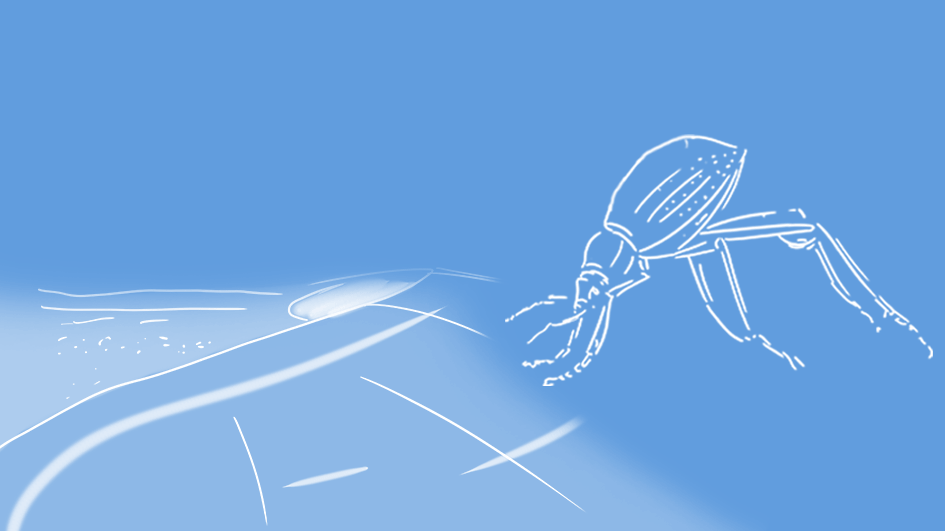
Aquora
"A water harvesting system capable of providing water to communities experiencing climate-related water scarcity. This bioinspired and energy-efficient Aquora tower concept collects and stores 200-350 liters of water per day for local use."
-press release Denhart Sustainability Prize 2019





Origin of Aquora
Step 1
Inspired by the dryness seen in
Switzerland due to climat change.

Meeting Future Water Needs
Step 2
By 2050 the world population will surpass 9.5 billion people.
How can we provide everyone with enough water?
The National Interest

Learning from Mother Nature
Step 3
The question arose;
How does nature create and store water?

Syntrichia Caninervis
This plant is able to
capture moisture from
the air on its thin hairs.
Cobweb
Spider net capture
rain droplets
Stenocara gracilipes
This desert beetle
harvests Water
from its back
Ananas comosus folium
Pineapples created a water capture for storage
Heraldik
Cactus have great Water Storage
and cooling Systems
Phylum Porifera
Sponges have great
Water storage






The beetle climbs up a dune, where it holds
its rear up and harvests the morning dew.
Water droplets form on its unique design body. Gravity pulls the droplets
directly into its mouth.
Step 4
The Water Harvesting
Nairobi Desert Beetle

Step 5
Where did humans already
apply the beetles strategy?
This is a 9.5m high water collecting
tower providing small rural villages
with 40 to 100 L of water a day.The
project has started in Ethiopia. This is
not sufficient for a typically sized village in Ethiopia, where 61M people lack
access to safe water. It's an inspiring solution that can be built upon.
Warka Water




Step 6
Analysing Warka Water
and planning futur Aquora
Top View
Warka Water

Aquora



Water harvest ca. 5h a day during morning dew.
Water harvest all day long through the help of a cooling system.
Top View
Only frame catches water.
Providing more effective use
of space by integrating the inner area of the structure.
Water evaporation possible. Structure has only little cooling provided through a mesh.
Preventing Water evaporation
by integrating a cooling system.
h
h
Step 7
Possible Cooling Systems for Water Creation and preventing Evaporation
In order for Aquora to create water throughout most of the day and prevent water evaporation,
it needs an efficient cooling System.
SkyCool a new technology-based company, this company realized the sky's potential. SkyCool created a coat that reflects more radiation back into the sky than other materials, leaving its close surrounding cool.



Diving into the three-dimensional world, the aspect of learning from nature was still important. Studying flowers and their forms. Analyzing through mockups how water flows
down the structure into its storage.
Creating possible
forms for Aquora
Step 8
Aquora's Structure
Step 9
Chpt. 7
Aquora's Anatomy

Shutters, made out of SkyCool,
to structure and channel the
wind individually and to keep
the villagers interacting with
the structure.

Hydrophobic and Hydrophilic mesh to harvest the water.

Turbine helps to rotate the mesh to distribute the water harvest to all panels. The Turbine is made out of aluminum.

Tube, inspired by pineapple
shape to collect rainwater.
Leathers within the structure help in case of maintenance.

Stairs for maintenance. Made out of teak wood.

Water storage covered
with SkyCool to prevent water evaporation.
Material
Step 10


Teak wood
Durable
Stands up to moisture
Resists warping
Resists cracking
Resists decay
Applied to
Vertical rods, stairs
Aluminium Alloy
Durable
Sustainable
Easy Recyclable
Applied to
Turbine, rainwater collector

SkyCool
This material helps
the condensation, keeps the inside of the structure
cool, and decreases evaporating.
Applied to
Shutters, storage

Fog harvesting Mesh
Includes hydrophobic and hydrophilic substances to attract and repel water.
Applied to
Mesh
Step 11
Sustainable Aspect
Social
Access to water.
A place for the community
to gather together.
Relatively affordable in
comparison to other water
creating products.
Economical
In humid climates, this structure can enhance job opportunities through its assembly, and partnering businesses can be created. (e.g. Vertical farming)
Environmental
Aquora can provide the surrounding ground with necessary water to revitalize the ground that may have dried out during
the past year.

Water Production
Step 12
This comes from the calculation of comparing Warka Water's mesh
dimensions and 2 to 3 hours of time to collect morning dew with Aquora's parameters coupled with its 12 hours of water harvest per day.
200 to 350L of water each day

Step 13
The Future of Aquora
This project would have to
collaborate with SkyCool and
start testing the concept and adjust
the system according to regular testing.
Where Aquora can be found
Step 14

Ethiopia
Madacascar
Colombia
Cameroon
San Francisco
Haiti
India
Sumba
Brasil
Togo

Aquora and Vertical Farming
Step 15
The concept's capabilities could be extended into complementary methods of water collection, generation, and recycling, like vertical farming
in countries with water shortage.
Vertical farming is a system
that uses 90% less water than
traditional farming and saves
valuable land through growing
food in levels.
Aquora and Privat Housing
Step 16
Furthermore, the concept could be integrated into urban architecture for private housing to have their own water system running in a sustainable way.


10
Chpt. 8
Living with Aquora
11

Thank you!
